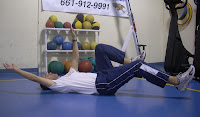When people ask me about my top core exercise I always have this little debate in my head. As I have stated in previous posts, there really needs to be a progression of exercises. So what I am going to do is give the top exercise in each of the 4 progressions: (1) postural control, (2) stabilization, (3) strength, 4 (power/reactive).
 |
| Pelvic Tilting |
1. The first exercise that should be done is simply Pelvic Tilts. The reason for this is that many people, in particular youth athletes have are not able to change the position of their hips on command. This is a fundamental skill that ALL athletes should possess. If an athlete is unable to do this, generally every other functional exercise is going to suffer.
To do a pelvic tilt exercise, have the athlete lie on their back with their knees bent. Have them place one hand under their back and simply alternate between lifting their back off their hand and putting pressure down on their hand. Hold each position for 2-5 seconds.
 |
| Full Side Plank |
To do the side plank support yourself on one arm with your feet stacked and hold that posture for between 20-45 seconds
 |
| Hand Walkout |
3. The best strength exercise is the Hand Walkout. Why? Well it trains the body in the sagittal plan, so it uses the rectus abdominus "six pack" muscle. But it also engages the obliques and transverse abdominus. The hand walkout is an "anti-extension" exercise that uses the postural control and strength of the prior to phases.
To do the hand walkout, simply start from a push-up position and take small steps forward with your hands, keeping your feet where they are. Walkout until you feel tension in your abdominals and then walk your hands back in.
4. The best plyometric/reactive exercise is Medicine Ball Shakers. This exercise requires the spinal stabilization muscles and the hip rotators to contract and relax rapidly. The ability to turn a muscle on and off quickly is crucial for sports performance and everyday living. And because most motion takes place in the rotational/transverse plane, this exercise is our champion.
Simply hold a medicine ball in front of you and quickly shake it side to side. Don't attempt to use a "full range of motion" because most people will end up over torquing the muscles of the lower back. Instead focus on short rotations that allow the ball to travel a maximum of 12" before you bring the ball back the other way. Perform 10 repetitions as fast as possible - shoot for under 6 seconds.









